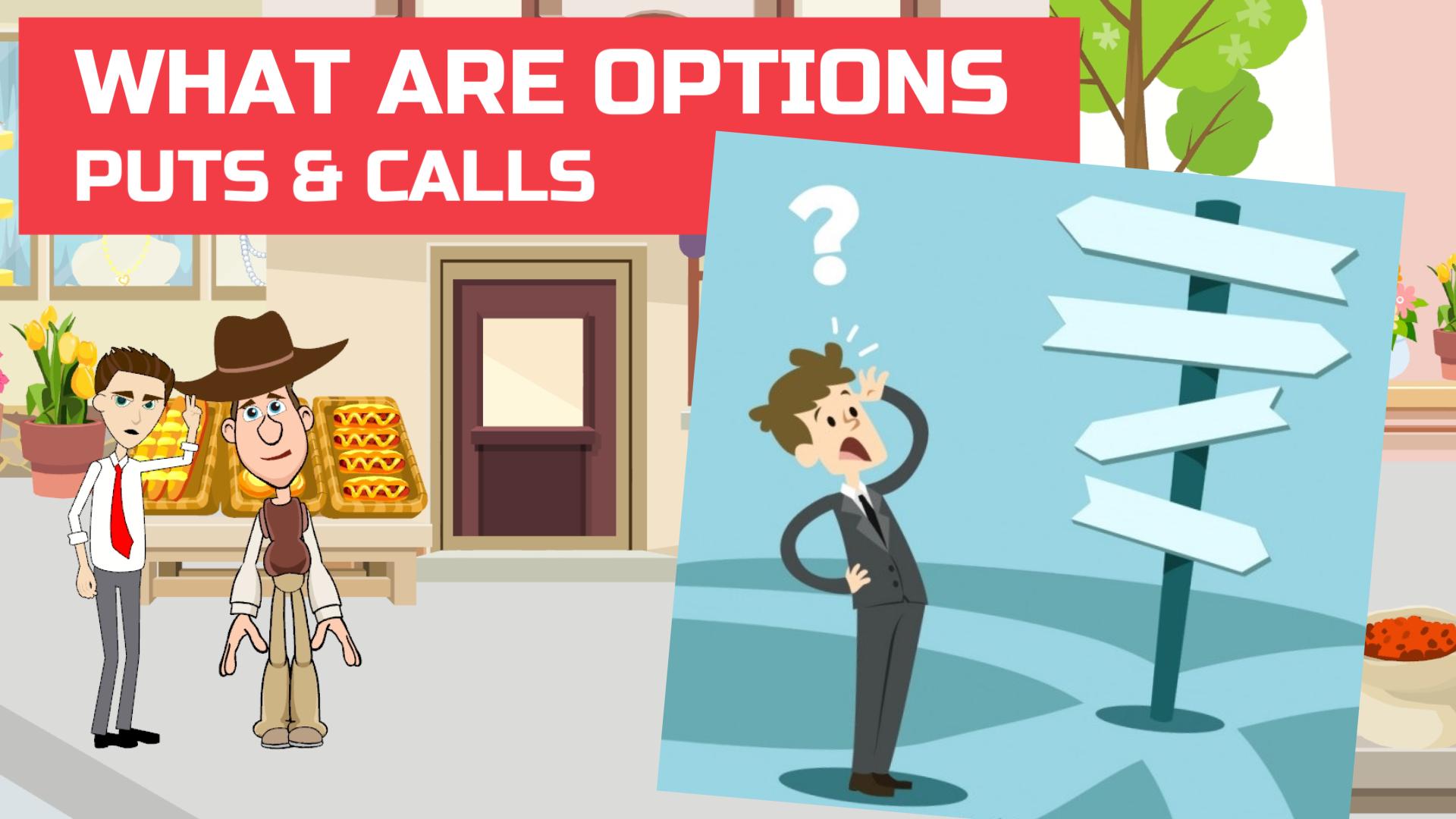Part 1: What are Options, Call and Put Options, Detailed Examples
Part 2: Pros and Cons of Options, Is Options Trading Right for You
Part 3: Options Trading Guide – What are Options Used For, How are Options Traded, How to Make Money from Options Trading
Introduction to Options Trading for Kids and Teens
This video explains what is option trading and how does it work in a simple, concise way for kids and beginners. It could be used by kids & teens to learn about options trading, or used as a money & personal finance resource by parents and teachers as part of a Financial Literacy course or K-12 curriculum.

Suitable for students from grade levels:
- Kindergarten
- Elementary School
- Middle School
- High School
The topics covered are:
- What are options
- What is a call option
- Example of a call option
- What is a put option
- Example of a put option
- Advantages of options
- Disadvantages of options
- Is options trading right for you
- How are options traded
- What are options used for
- Can you really make money trading options
What are Options?
Options are a type of derivative that give the buyer the ability to buy or sell a fixed amount of an underlying asset at a certain price, called the strike price, by a certain date, called the expiration date.

The underlying asset could be stocks, Exchange Traded Funds – ETFs, currency, commodities, etc.
Options are sold in the form of a contract by the seller, also called the option writer, to the buyer for a fee – called the premium.
The buyer does not need to use – or exercise – the option. The buyer will exercise the option only if the conditions are favorable.
On the other hand, the option writer is obligated to buy or sell the underlying if the buyer exercises the option.
There are two types of options: Puts and Calls.
What is a Call Option?
Call options give the buyer of the option the right – but not the obligation – to buy the underlying asset from the option writer, at a certain price by a certain date.
The price paid by the option buyer for this right is called the premium.
Buying a call option makes sense when you expect the price of the underlying asset to go up in the future.
Can you give me an example of a Call Option?
Let’s say company X’s stock is currently trading for $10 a share but you expect it to go up in the near term. You can then buy a call option on X with a strike price of $13 and an expiration date in 3 months, say at a premium of $1 per share.
Now anytime before the expiration date, you can exercise the option if the price of the underlying stock goes up. For instance, if the stock price goes up to $20, you can exercise your option of buying it at $13.
Including the option premium, your total cost is $14 per share, giving you a profit of $6 per share.
However, if the stock price stays the same or goes down, it doesn’t make sense to exercise the option and you would let it expire. Your maximum loss in this case will be the $1 option premium paid per share.
The call option writer or seller is on the other side of the contract and wants the stock to move in the opposite direction to the option buyer.
The writer of the call option makes money when the price of the stock stays the same or goes down, as it would make the option expire worthless, without being exercised. The option writer gets to keep the premium as the profit.
However, if the stock price goes up and the buyer exercises the option, the option writer would have to sell the stock at a lower price (strike price) than the market price and would end up making a loss.
What is a Put Option?
Put options give the buyer of the option the right – but not the obligation – to sell the underlying asset to the option writer, at a certain price by a certain date.
The price paid by the option buyer for this right is called the premium.
Buying a put option makes sense when you expect the price of the underlying asset to go down in the future.
Can you give me an example of a Put Option?
Let’s say company Z’s stock is currently trading for $20 a share but you expect it to go down in the near term. You can then buy a put option on Z with a strike price of $18 and an expiration date in 3 months, say at a premium of $1 per share.
Now anytime before the expiration date, you can exercise the option if the price of the underlying stock goes down. For instance, if the stock price goes down to $10, you can exercise your option of selling it at $18.

Even accounting for the option premium of $1, you earn a profit of $7 per share.
However, if the stock price stays the same or goes up, it doesn’t make sense to exercise the option and you would just let it expire. Your maximum loss in this case will be the $1 option premium paid per share.
The put option writer or seller is on the other side of the contract and wants the stock to move in the opposite direction to the option buyer.
The writer of the put option makes money when the price of the stock stays the same or goes up as it would make the option expire worthless, without being exercised. The option writer gets to keep the premium as the profit.
However, if the stock price goes down and the buyer exercises the option, the option writer would have to buy the stock at a higher price (strike price) than the market price and would end up making a loss.
What are the advantages of options?
The biggest advantage is that the option buyer has the right – but no obligation – to exercise the option. This means they are not locked into the deal. They can wait and see how the market plays out, and only move forward if the trade is favorable to them.
The potential loss to the buyer is limited to the premium paid, since the buyer can always choose to let the option expire.
Another benefit is the leverage. For the same amount of money, the buyer gets exposure to a lot more shares than if they were to buy the stock outright, as they only have to pay the premium upfront.
With the large contract sizes, small movements in the stock price in the right direction can have magnified returns in a short period.
Also, options are very liquid assets, meaning they can be quickly sold to generate cash, if needed.
What are the disadvantages of options?
Options are highly volatile and prices can move substantially even within the same day, making them very risky.
The leverage is a double edged sword – if the underlying asset moves unfavorably, the losses are magnified too, meaning you could lose your entire investment very quickly.

Options have a finite life after which they expire. So they are not good for buy-and-hold investing.
Also, if the option expires out-of-the-money, the option buyer loses their entire investment (the premium).
The option seller is obligated to move forward with the trade if the buyer chooses to exercise the option. This could result in huge losses – in the case of calls, there is no limit to how high the stock price can go, which means there is no limit to the loss incurred by the option writer.
Similarly, in the case of puts, even if the stock price goes to zero, the option writer is obligated to buy the shares at the strike price when the option buyer exercises the option.
Is options trading right for me?
Despite the advantages, options trading is far too complex, expensive, and risky for individual investors.
Options are complex because they require a very high level of skill and knowledge to trade effectively. Traders must look at a great deal of different factors and be able to make quick adjustments to their portfolio based on market movements.
Also, options are extremely risky investments. Because of their leveraged nature and the difficulty of anticipating price changes, options prices are extremely volatile and investing in them comes with a very high possibility of losing money.
Lastly, options can be very capital intensive investments due to the contract size and many high fees involved.
All this means that options trading should only be done by experienced, professional traders who can manage the risks and complexities and have enough capital to withstand big losses.
What is Options Trading? How does option trading work?
Buying and selling options is called Options Trading. Like stocks, most options are traded on an exchange, but there are some private options that are traded over the counter.
Each options contract is usually for 100 shares of the underlying stock, although multiple contracts can be bought and sold in one transaction.
The contract duration could range from 30 days to a year. The further the expiration date, the higher is the option premium, since the possibility of the option becoming profitable for the buyer is greater.
Although options can be used to buy or sell the underlying stocks, they are more often used in options trading, where people buy options and sell them to someone else at a higher price – without ever exercising the option.
Options trading is much more complex than other types of investing – such as trading stocks. Although individuals like you and me can trade options, the vast majority of options trading is done by institutional investors, broker-dealers, and market makers who increase option liquidity.
What are options used for?
Options can be used for a variety of purposes, the most common being hedging, speculation, and profits from trading.

Hedging involves using options to decrease a portfolio’s risk. For instance, if you own stock in a certain company but are worried the price will fall significantly in the short term, you can buy a put option.
This way if the price falls, you can exercise the put option to sell the stock at a strike price higher than the current market value.
On the other hand, if the price increases, you can sell your stock in the market and only lose the premium you paid for the put option.
Speculation involves using options to increase leverage so gains are amplified.
If you had $100 to invest and the price of a stock is $10, you can only buy 10 shares of that stock. Instead if you choose to invest in options, you will only need to pay the premium, say around $1 per share, giving you exposure to 100 shares – which is 10 times more than buying the stock outright.
Lastly, some people simply want to trade options for a profit, by attempting to sell them for a higher price than they bought them for. Very few options trades are made with the intent to actually exercise the option.
How do I make money from options trading?
An options contract is profitable, also called in-the-money, or unprofitable, also called out-of-the-money, based on how the underlying asset’s price moves with respect to the strike price.
A call option is in-the-money when the underlying stock’s market price is above the strike price. A put option is in-the-money when the underlying stock’s market price is below the strike price.
In both cases, the option buyer can exercise the option for a profit.
Similarly, a call option is out-of-the-money when the underlying stock’s market price is below the strike price. And a put option is out-of-the-money when the underlying stock’s market price is above the strike price.
In both cases, the option buyer should not exercise the option and instead let it expire.
The option seller makes money only when the call or put options are out-of-the-money. Their profit is the option premium.
There are many options trading strategies, but that’s a topic for another time…
Download Transcript: Ideal for Use by Teachers in their Lesson Plan to Teach Kids & Teens
Part 1: What are Options, Call and Put Options, Detailed Examples
Part 2: Pros and Cons of Options, Is Options Trading Right for You
Part 3: Options Trading Guide – What are Options Used For, How are Options Traded, How to Make Money from Options Trading

